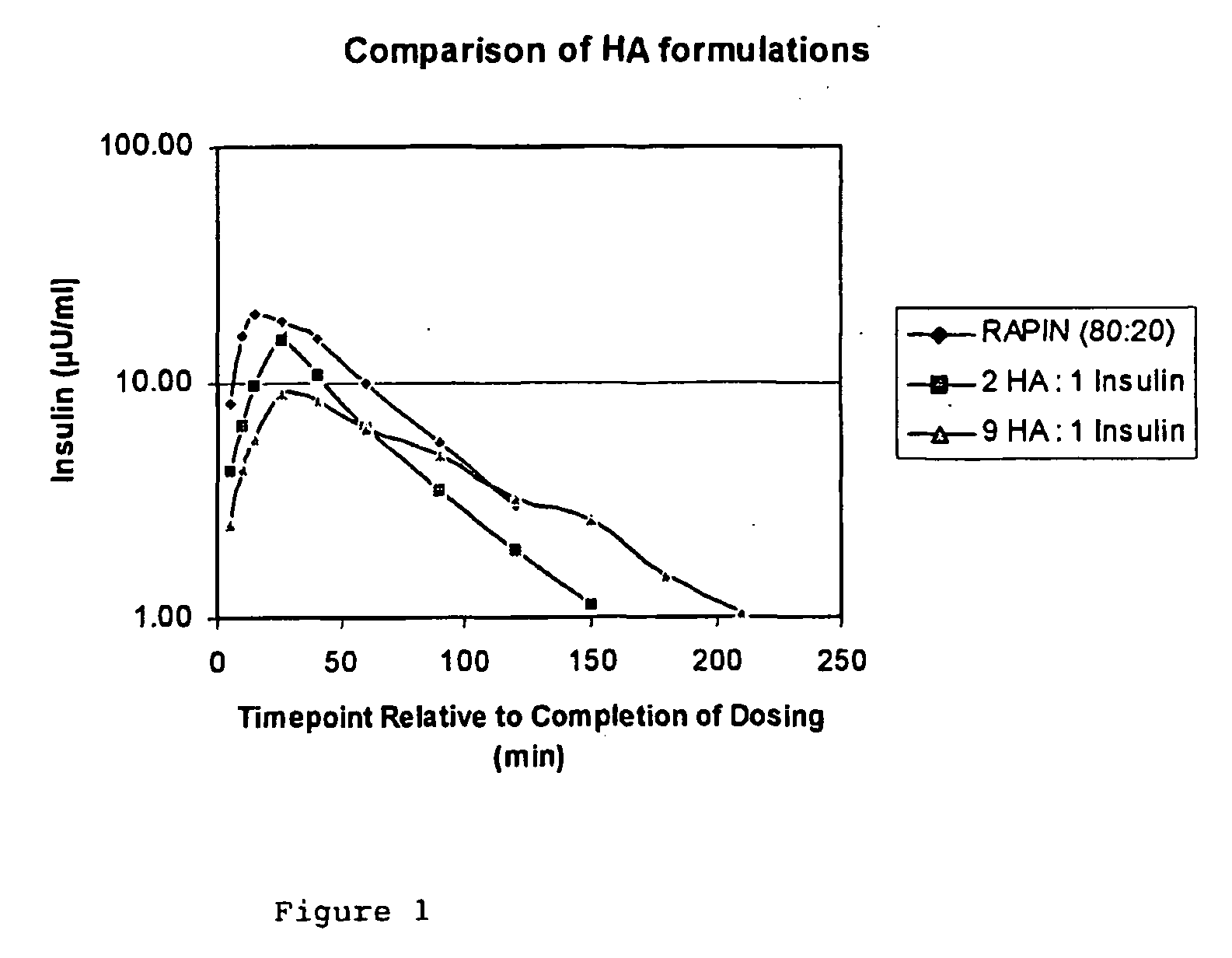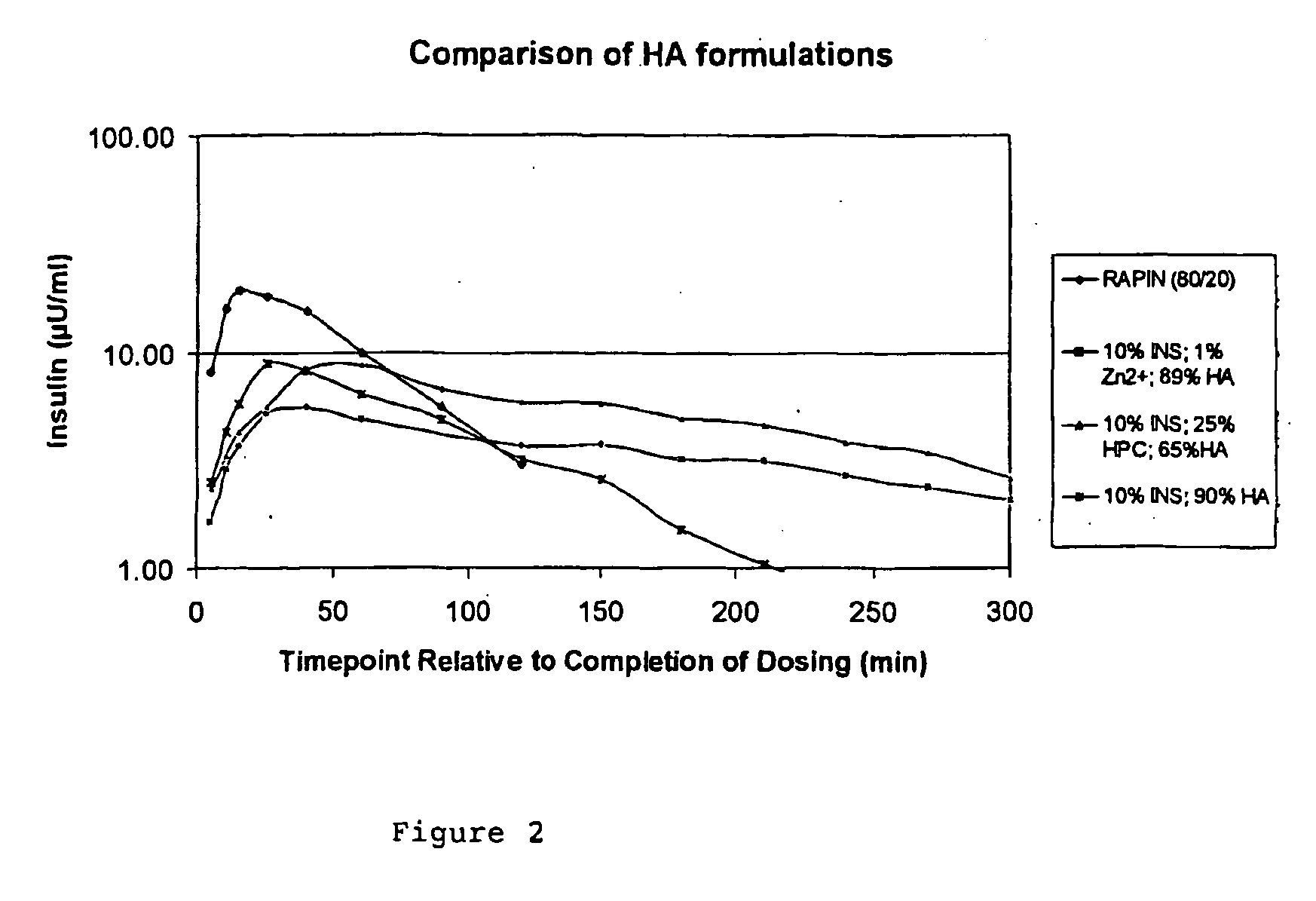Sustained-release compositions
a technology of compositions and suspensions, applied in the direction of inorganic non-active ingredients, peptide/protein ingredients, pharmaceutical non-active ingredients, etc., can solve the problems of difficult injection, unsuitable formulations for pulmonary delivery, and inability to maintain drug release for more than 24 hours
- Summary
- Abstract
- Description
- Claims
- Application Information
AI Technical Summary
Benefits of technology
Problems solved by technology
Method used
Image
Examples
example 1
[0058] This is a comparative example, using only hyaluronic acid as the matrix former.
[0059] 55.5 mg recombinant human insulin was dissolved in 0.77 ml 0.05M HCl with gentle agitation. To this was added 0.05 ml 1M NaOH dropwise, with gentle stirring. To this solution was added 155.6 ml of 0.3% w / v hyaluronic acid [2 MDa] and the solution was then made up to the desired volume with 17.58 ml purified water. 185 ml of this feedstock was then dried using an in-house spray-dryer under the following conditions; feed rate=2.0 g / min, inlet temp=130° C., outlet temp=89° C., atomisation=2-fluid nozzle, atomisation pressure=1.1 barg, atomisation flow rate=15 l / min, drying air pressure=1 barg, drying air flow rate=4.5 l / sec. Total recovery was low (11%). The final product had a mass ratio of 1:9 insulin:HA. A second formulation was prepared with a ratio of 1:2 insulin: HA. These formulations were then administered to beagle dogs, whose endogenous insulin was suppressed by i.v. administration o...
example 2
[0060] A formulation containing 25% w / w HPC (ex. Nippo Soda Co., Japan) 10% w / w recombinant human insulin and 65% w / w high molecular weight hyaluronic acid was prepared as follows. To 154 mg insulin was added 2.16 ml 0.05M HCl and this was then swirled gently until the insulin dissolved. To this solution was added dropwise 0.14 ml 1M NaOH together with 165 ml purified water. This solution was then added to 96.25 ml of 0.4% w / v HPC solution and then 250 ml of a 0.4% w / v solution of high molecular weight hyaluronic acid was added and the mixture stirred until homogenous. Approximately 500 ml of this feedstock was spray dried at the following settings: feed rate=2.1 g / min, inlet temp=130° C., outlet temp=66° C., atomisation=2-fluid nozzle, atomisation pressure=2 barg, atomisation air flow rate=21 l / min, drying air pressure=1 barg, drying air flow rate=5 l / sec. Small powder doses were administered to dogs, as described in example 1.
[0061] The results are shown in FIG. 2. The profile de...
example 3
[0062] This Example illustrates the third aspect of the invention.
[0063] Insulin (0.1 g) was dissolved in hydrochloric acid (0.05 M, 1.4 ml). Sodium hydroxide (1 M, 0.09 ml) was added dropwise to the solution, until the initially precipitated insulin had redissolved. The insulin solution was then diluted with 106.8 ml water (99.3 ml for Zn2+ containing solutions). All feedstocks were prepared to give a loading of 10% w / w insulin in the dried powder.
[0064] ZnCl2 (0.01 g) was dissolved in water (10 ml). Sodium hyaluronate (0.89 g) was gently dissolved in water (222.5 ml). The zinc solution was added to the HA solution, closely followed by the insulin solution; the whole feedstock was stirred gently to release trapped air bubbles.
[0065] In all cases, a feedstock of 0.3% w / v containing 1 g of total solids was prepared. This allowed efficient atomisation of the solution. Significantly higher concentrations could not be used due to the high viscosity of HA.
[0066] The release profile o...
PUM
| Property | Measurement | Unit |
|---|---|---|
| Diameter | aaaaa | aaaaa |
| Diameter | aaaaa | aaaaa |
| Diameter | aaaaa | aaaaa |
Abstract
Description
Claims
Application Information
 Login to View More
Login to View More - R&D
- Intellectual Property
- Life Sciences
- Materials
- Tech Scout
- Unparalleled Data Quality
- Higher Quality Content
- 60% Fewer Hallucinations
Browse by: Latest US Patents, China's latest patents, Technical Efficacy Thesaurus, Application Domain, Technology Topic, Popular Technical Reports.
© 2025 PatSnap. All rights reserved.Legal|Privacy policy|Modern Slavery Act Transparency Statement|Sitemap|About US| Contact US: help@patsnap.com


